Have you ever wondered how farmers separate grains from harvested crops or how pure salt is obtained from seawater? The explanation lies in the amazing Methods of Separation that we use all around us.
In this chapter on Methods of Separation in Everyday Life, you will understand how and why we separate different types of mixtures using simple techniques. You will learn important methods such as handpicking, threshing, winnowing, sieving, filtration, sedimentation, decantation, evaporation and magnetic separation with real-life examples.
Each concept is explained with simple illustrations and examples, making it easy to understand and apply during your Class 6 Science learning. A practice worksheet is also included to test your understanding. Don’t forget to download.
Get ready to become a master of separation as we delve into the world of mixtures and their components!
Methods of separation in Everyday life
You will learn how mixtures are separated using methods such as handpicking, sieving, winnowing, filtration and evaporation. Real-life examples and simple explanations will help you understand each separation method clearly and quickly.
Download our Methods of separation in everyday life PDF today and test what you have learned in the chapter.
Methods of Separating Mixtures
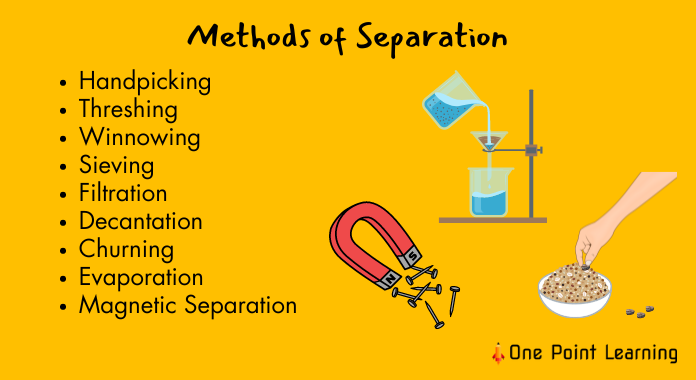
1. Introduction
Mixtures: Combinations of two or more substances that are not chemically combined.
Separation: The process of separating the components of a mixture.
2. Importance of Separation Techniques
How separation techniques are used in daily life is often overlooked, yet they are fundamental to many of our routines. Some methods we use are:
- Filtration: a simple example is how we separate tea leaves from our brewed tea using a strainer.
- Washing: Washing fruits and vegetables involves separating dirt and debris from the edible portions.
- Churning: separating butter and butter milk.
- Sieving: removing stones from grains
These examples illustrate just how separation techniques, from the most basic to more advanced processes, are integral to maintaining hygiene, preparing food, and managing waste in our daily lives.
Separation techniques used in various fields:
- Purification: Obtaining pure substances from mixtures (e.g., removing impurities from water)
- Recycling: Separating materials for reuse (e.g., separating plastic from paper in waste)
- Agriculture: Separating grains from stalks (e.g., wheat, rice)
- Chemical industry: Separating products from chemical reactions
Also download:
Class 6 Hindi Worksheet with Answers
Science Worksheets for Class 6
3. Applications of Different Methods of Separating Mixtures in Day to Day Life
1. Handpicking
Manually selecting individual components from a mixture based on their appearance or size.
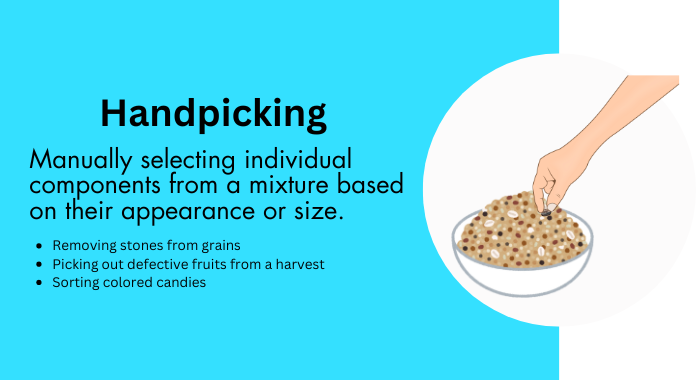
- Removing stones from grains
- Picking out defective fruits from a harvest
- Sorting colored candies
2. Threshing
Separating grains from their stalks by beating or rubbing.
- Threshing wheat or rice to separate the grains from the stalks
- Using a flail or a machine to thresh grains
3. Winnowing
Separating lighter particles (like chaff) from heavier particles (like grains) using wind or a fan.
- Winnowing wheat or rice after threshing to remove the chaff
- Separating rice grains from broken pieces
4. Sieving
Separating particles based on their size using a sieve (a mesh or screen with holes of a specific size).
- Sieving flour to remove lumps
- Separating sand from gravel
- Sifting soil to remove rocks
5. Filtration
Filtration separates a solid from a liquid using a porous material (filter) that allows the liquid to pass through but traps the solid particles.
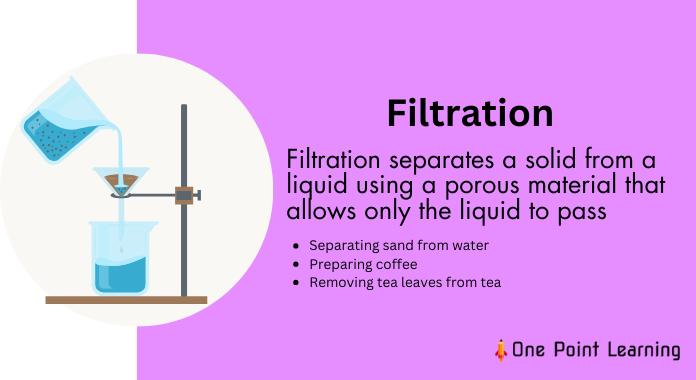
- The coffee grounds are separated from the brewed coffee using a filter.
- Water filters are used to remove impurities like dirt, bacteria, and other contaminants.
- Separating sand from water
6. Decantation
Decantation is used to separate two immiscible liquids (liquids that do not mix) based on their different densities. The denser liquid settles to the bottom, and the less dense liquid can be poured off.
- Separation of oil from water: Oil floats on top of water due to its lower density. It can be decanted off by carefully pouring the water into another container.
- Separating cream from milk: The cream rises to the top of milk due to its lower density. It can be skimmed off or decanted.
7. Churning
Separating solid fat from liquid by agitating or shaking the mixture.
- Churning cream to make butter
- Making whipped cream
8. Evaporation
Evaporation involves heating a liquid to vaporize it, leaving behind the dissolved solid.
- Obtaining salt from seawater: By heating seawater, the water evaporates, leaving behind the salt.
- Drying clothes: The water in wet clothes evaporates, leaving the clothes dry.
- Preparing sugar crystals: Heating a sugar solution to evaporate the water can produce sugar crystals.
9. Magnetic Separation
Magnetic separation uses a magnet to attract and separate magnetic materials from a mixture.
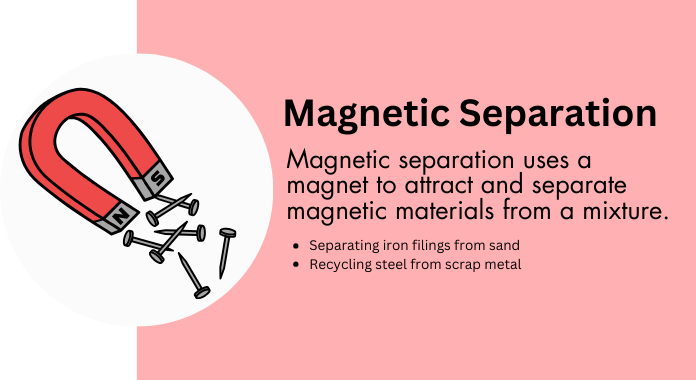
- Separating iron filings from sand: A magnet can be used to attract iron filings and separate them from non-magnetic materials like sand.
- Recycling scrap metal: Magnetic separators are used to separate iron and steel from other metals in recycling facilities.
Methods of separation Info-graphic
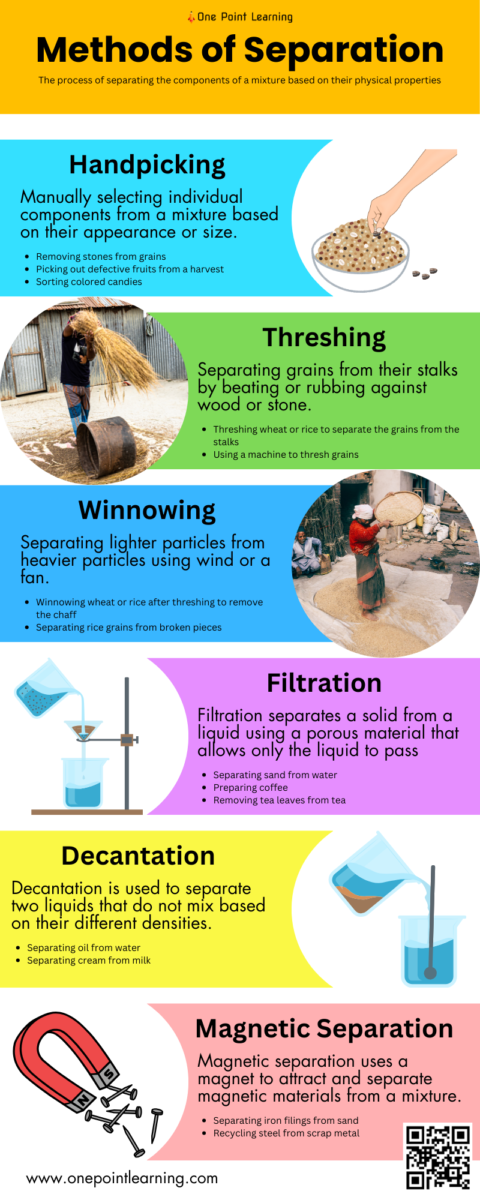
Conclusion
Throughout this chapter, we have explored the fascinating world of separation techniques. Separation techniques are essential in our daily lives and industries. They help us purify substances, recycle materials, and extract valuable components from mixtures.
Moreover, our Methods of Separation in everyday life Class 6 worksheet will help you test your knowledge and score better in exams.
Frequently Asked Questions
Que. What is separation method?
Ans. Separation method is the technique of separating different components of a mixture into pure substances.
Que. What are the main methods of separation?
Ans. Methods of separation include hand-picking, threshing, winnowing, sieving, evaporation, filtration, decantation, magnetic separation, and centrifugation.
Que. Explain the application of separating mixtures in day to day life with suitable examples?
Ans. We use various methods to separate mixtures in our daily life. We often separate mixtures to remove unwanted materials or to collect useful ones. For example, we use handpicking to remove stones from grains, winnowing to separate husk from wheat, and sieving to clean flour before cooking. At home, filtration is used to separate tea leaves from tea, while decantation helps in separating clean water from muddy water. Evaporation is used to get salt from seawater. These simple methods of separation play an important role in keeping our food, water, and environment clean and safe.
Que. How separation techniques are being used in our daily life?
Ans. We use various separation techniques, from the most basic to more advanced for maintaining hygiene, preparing food, and managing waste in our daily lives. Some separation techniques used in daily life are filtration, churning, sieving and handpicking.
Que. What are the 5 examples of decantation?
Ans.
Separating oil from water
Separating cream from milk
plasma separation from blood
Separating Kerosene and water
separation of syrups from crystals
Que. Explain various water separation methods?
Ans. To make the water clean or to get useful materials from it, we use different methods to separate water from other substances. These are called water separation methods.
Method 1. Sedimentation and Decantation
Sedimentation: When muddy water is left still, the mud (heavier particles) settles down at the bottom.
Decantation: Then, the clean water from the top is carefully poured into another container.
Example: Cleaning muddy water by letting the mud settle and pouring the clean water out.
Method 2. Filtration
This method is used to remove solid particles from water by passing it through a filter like cloth, sand, or filter paper.
Example: Removing tea leaves from tea using a strainer or filtering muddy water through a cloth.
Method 3. Evaporation
In this method, water is heated and changes into water vapor, leaving behind the dissolved solids.
Example: Getting salt from seawater by evaporating the water in the sun.
Que. What is winnowing?
Ans. The process of separating lighter and heavier components of a mixture using wind or blowing air.
Que. What is an example of sieving?
Ans.
Sieving flour to remove lumps
Separating sand from gravel
Sifting soil to remove rocks



